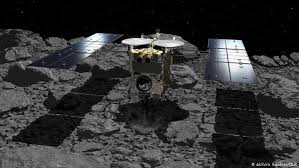For the first time, Japan’s space agency has retrieved a capsule carrying the first rock samples from beneath the surface of an asteroid. The spacecraft Hayabusa2 released the small capsule on Saturday and sent it towards Earth to deliver samples from the asteroid Ryugu, about 300 million kilometers (180 million miles)
The scientists say could provide clues to the origin of the solar system and life on our planet.
The Japan Aerospace Exploration Agency (JAXA) said, “The capsule collection work at the landing site was completed. We practiced a lot for today … it ended safely.”
The return of the capsule with the world’s first asteroid subsurface samples comes weeks after NASA’s OSIRIS-REx spacecraft made a successful touch-and-go grab of surface samples from asteroid Bennu.
Early on Sunday, the capsule briefly turned into a fireball as it re-entered the atmosphere 120 km (75 miles) above Earth.
At about 10 km (6 miles) above ground, a parachute was opened to slow its fall, and beacon signals were transmitted to indicate its location.
The capsule descended from 220,000 km (136,700 miles) away after it was separated from Hayabusa2 is a challenging operation that required precision control.
About two hours after the capsule’s re-entry, JAXA said its helicopter search team found the capsule in the planned landing area in a remote, sparsely populated area of Woomera, Australia. The retrieval of the pan-shaped capsule, about 40 centimeters (15 inches) in diameter, was completed about two hours later.
JAXA officials said they hoped to conduct a preliminary safety inspection at an Australian lab and bring the capsule back to Japan early next week.
The material collected from the asteroid is believed to be unchanged since the time the universe was formed. Larger celestial bodies like Earth went through radical changes including heating and solidifying, changing the composition of the materials on their surface and below.
Half the Hayabusa-2 samples will be shared between JAXA, US space agency NASA and other international organizations and the rest kept for future study as advances are made in analytic technology.
For Hayabusa2, it is not the end of the mission it started in 2014. It is now heading to a small asteroid called 1998KY26 on a journey slated to take 10 years one way, for possible research including finding ways to prevent meteorites from hitting Earth.
So far, its mission has been fully successful. It touched down twice on Ryugu despite the asteroid’s extremely rocky surface, and successfully collected data and samples during the one and a half years it spent near Ryugu after arriving there in June 2018.
In its first touchdown in February 2019, it collected surface dust samples. In a more challenging mission in July that year, it collected underground samples from the asteroid for the first time in space history after landing in a crater that it created earlier by blasting the asteroid’s surface.
Asteroids, which orbit the sun but are much smaller than planets, are among the oldest objects in the solar system and therefore may help explain how Earth evolved.



